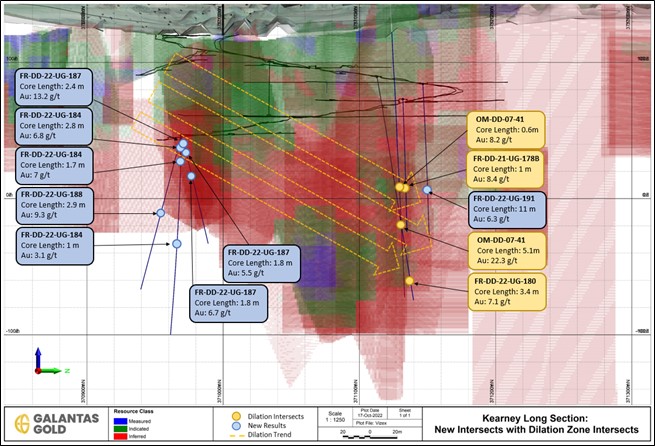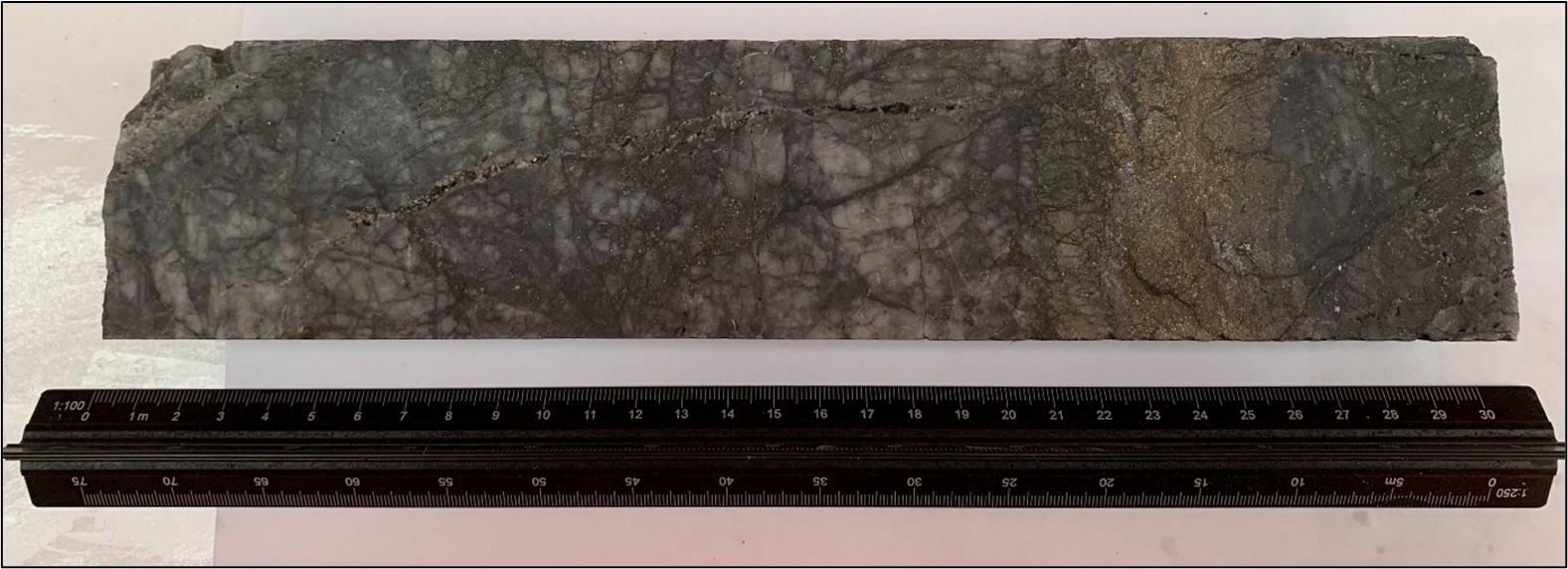
Galantas Gold (TSXV:GAL) has released results from four drill holes from the ongoing drilling program at the Omagh Project in Northern Ireland. From an underground platform toward the south of the development on the Kearney Vein, three holes were drilled with one drilled from a new platform to the north.
Mario Stifano, CEO of Galantas, commented in a press release: “These results underscore the success of the drilling program at the Omagh Gold Project by extending the dilation zones at the main Kearney Vein further north, as we predicted from earlier drilling. We are pleased that our drill data so far is supporting the theory that dilation zones – a pattern of vein swelling and grade increases – are projected at depth and predictably identified at regular intervals along strike of the first five levels of the Kearney Vein underground development.”
*Dilation zones which have potential for higher widths of mineralization have previously been identified within the Kearney underground development and are believed to be linked on shallow north-dipping planes.
Highlights from the results are as follows:
- Hole FR-DD-22-UG-191 targeted a northern extension to a proposed dilation zone* within the Kearney Vein, intersecting 6.3 grams per tonne (g/t) gold (Au) and 32.1 g/t silver (Ag) over 11 metres (see Table 1 and Figure 1). This includes a higher grade section of 14.2 g/t Au and 59.3 g/t Ag over 4.5 metres.
- Hole FR-DD-22-UG-188, drilled from the lowest drill platform, intersected the main Kearney Vein 40 metres below the resource model at 9.3 g/t Au and 23.3 g/t Ag over 2.9 metres.
- Holes FR-DD-22-UG-187 and 184 both intersected the main Kearney Vein and the B-lens with B-lens intersections in the inferred resource and approximately 50 metres beneath the resource model, respectively. The B-lens is a vein that runs parallel to the Kearney Vein, approximately 17 metres east in this area.

Table 1: Summary of drill results.
| Hole ID | Azimuth/ Dip (degrees) | Intersect (m) (downhole) | Est. true width (m) | Intersect vertical depth (m)* | Gold (g/t) | Silver (g/t) | Lead (%) | Core loss (%) |
| FR-DD-22-UG-191 | 277.2/74 | 11 | 3 | 169 | 6.3 | 32.1 | 0.9 | 3.3 |
| Including | 4.5 | 1.2 | 14.2 | 59.3 | 1.5 | 6.9 | ||
| FR-DD-22-UG-188 | 121.5/63 | 2.9 | 1.1 | 170 | 9.3 | 23.3 | 2.6 | 0 |
| FR-DD-22-UG-187 | 073/49 | 2.4 | 1.5 | 128 | 13.2 | 27.7 | 1 | 3 |
| And | 073/49 | 1.8 | 1.1 | 133 | 5.5 | 5 | 0 | 23.5 |
| And | 072.5/52 | 1.8 | 1.1 | 152 | 6.7 | 8.6 | 0.3 | 6.9 |
| FR-DD-22-UG-184 | 090/62 | 2.8 | 1.3 | 130 | 6.8 | 8.3 | 0.6 | 18.1 |
| And | 093/62.1 | 1.7 | 0.8 | 141 | 7 | 11.8 | 0.4 | 43.2 |
| And | 099.9/64.2 | 1 | 0.4 | 199 | 3.1 | 3.7 | 0.4 | 0 |
Notes:
- Drill holes were HQ size and drilled using a triple tube method to maximize core recovery. The samples were analyzed (gold by fire assay and other metals by ICP-ORE) at ALS Laboratory Ltd (ISO 17025) of Galway, Ireland.
- Intersect vertical depth intervals are from ground surface to the top of the mineralized zone.
- Data has been rounded to 1 decimal place.
- All assays are reported without application of a top cut.
- Three of the reported intersections have an abnormally high core loss that may bias (either positively or negatively) the assay value for those intersections, and thus these intersections may not be fully representative of the true intersect value. These core losses were recorded as cavities during the drill process.



 Follow us on Twitter
Follow us on Twitter Become our facebook fan
Become our facebook fan










Comments are closed.